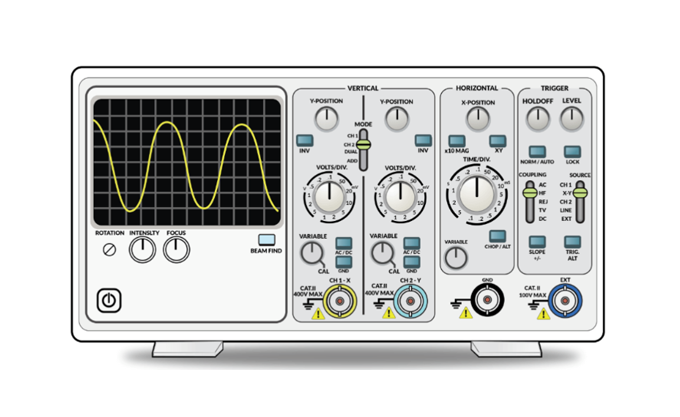Oscilloscope knowledge | Oscilloscope trends and basic indicators
Oscilloscope trends
High performance and versatility are two trends in the development of oscilloscopes. An example of high performance is Agilent Technologies' 63GHz analog bandwidth, 160GSa/s sampling real-time oscilloscope with both low noise and high input dynamic range characteristics, and the U.S. Liko announced a 65GHz analog bandwidth, 160GS/s real-time sampling rate, 4~40 channels of any channel oscilloscope system, significantly optimizing the channel selectivity of the oscilloscope. Another trend is universal, will be more functions integrated into the oscilloscope, common will be integrated logic analysis functions to form a hybrid model oscilloscope; will be integrated protocol analysis functions, and recently Agilent will be integrated into the oscilloscope signal source. Rico also in the full range of oscilloscopes plus logic module, with the development of technology, perhaps oscilloscopes will integrate more and more functions.
Oscilloscope basic indicators (digital)
Bandwidth, sampling rate and storage depth are the three main technical indicators of oscilloscopes. The bandwidth of an oscilloscope is defined as the signal frequency when the signal is attenuated by 3dB. If an oscilloscope bandwidth is not enough will lead to see the signal distortion, testing inaccurate. Bandwidth indicators are mainly reflected in the attenuator and amplifier indicators. Instant sampling rate reflects the indicators of the ADC of the oscilloscope. The sampling rate is usually greater than or equal to four times the bandwidth. Storage depth affects the length of observation time, in addition to the oscilloscope's sampling rate. Because the storage depth = sampling rate × observation time, if the observation time is longer (related to the horizontal observation time), the sampling rate will be reduced. In addition, the waveform capture rate and oscilloscope response speed, the number of trigger conditions, the bottom noise situation, ease of use, and expandability also reflects the effectiveness of the oscilloscope.
What are the main manufacturers of oscilloscopes?
United States: Tektronix, Keysight, formerly Agilent (Agilent) of the electronic instrumentation division, and before that, the instrumentation division of Hewlett-Packard (HP)), Fluke, LeCroy, National Instruments
The Netherlands: Philips (its instrumentation division merged with the U.S. Fluke in the 1990s)
Germany: R&S, Rohde & Schwarz, formerly HAMEG
UK: GOULD, closed for business in 2014
Japan: Hitachi, KIKUSUI Electronics, IWATSU ELECTRIC, Kenwood/Trio, Leader
China: Rigol, Siglent
Taiwan: GWInstek
Oscilloscope trends
High performance and versatility are two trends in the development of oscilloscopes. An example of high performance is Agilent Technologies' 63GHz analog bandwidth, 160GSa/s sampling real-time oscilloscope with both low noise and high input dynamic range characteristics, and the U.S. Liko announced a 65GHz analog bandwidth, 160GS/s real-time sampling rate, 4~40 channels of any channel oscilloscope system, significantly optimizing the channel selectivity of the oscilloscope. Another trend is universal, will be more functions integrated into the oscilloscope, common will be integrated logic analysis functions to form a hybrid model oscilloscope; will be integrated protocol analysis functions, and recently Agilent will be integrated into the oscilloscope signal source. Rico also in the full range of oscilloscopes plus logic module, with the development of technology, perhaps oscilloscopes will integrate more and more functions.
Oscilloscope basic indicators (digital)
Bandwidth, sampling rate and storage depth are the three main technical indicators of oscilloscopes. The bandwidth of an oscilloscope is defined as the signal frequency when the signal is attenuated by 3dB. If an oscilloscope bandwidth is not enough will lead to see the signal distortion, testing inaccurate. Bandwidth indicators are mainly reflected in the attenuator and amplifier indicators. Instant sampling rate reflects the indicators of the ADC of the oscilloscope. The sampling rate is usually greater than or equal to four times the bandwidth. Storage depth affects the length of observation time, in addition to the oscilloscope's sampling rate. Because the storage depth = sampling rate × observation time, if the observation time is longer (related to the horizontal observation time), the sampling rate will be reduced. In addition, the waveform capture rate and oscilloscope response speed, the number of trigger conditions, the bottom noise situation, ease of use, and expandability also reflects the effectiveness of the oscilloscope.
What are the main manufacturers of oscilloscopes?
United States: Tektronix, Keysight, formerly Agilent (Agilent) of the electronic instrumentation division, and before that, the instrumentation division of Hewlett-Packard (HP)), Fluke, LeCroy, National Instruments
The Netherlands: Philips (its instrumentation division merged with the U.S. Fluke in the 1990s)
Germany: R&S, Rohde & Schwarz, formerly HAMEG
UK: GOULD, closed for business in 2014
Japan: Hitachi, KIKUSUI Electronics, IWATSU ELECTRIC, Kenwood/Trio, Leader
China: Rigol, Siglent
Taiwan: GWInstek












